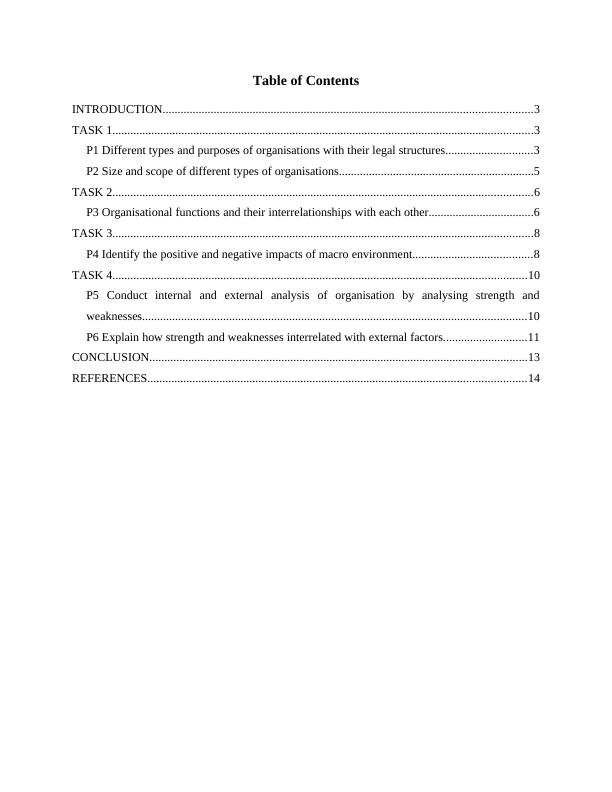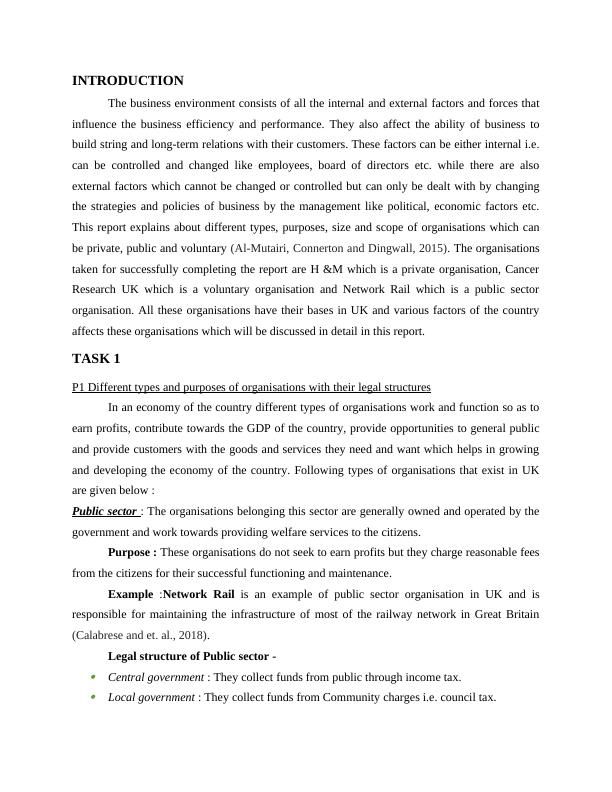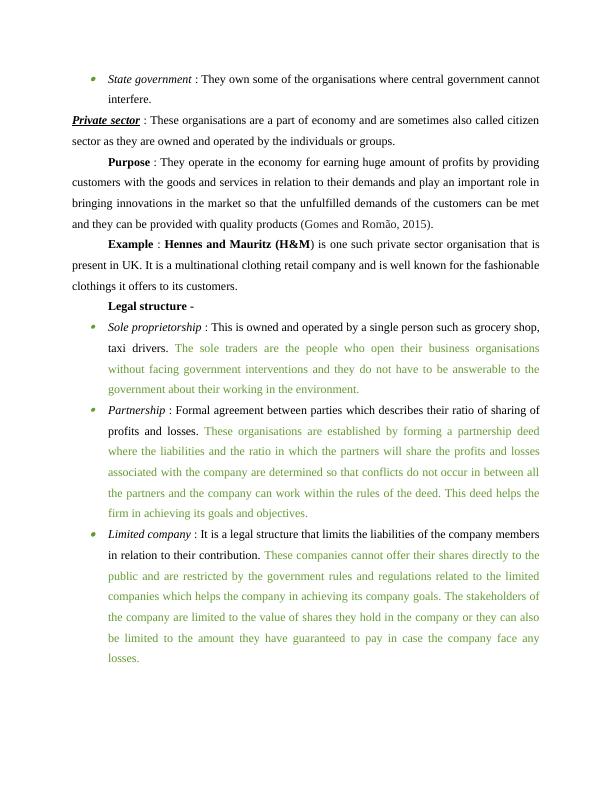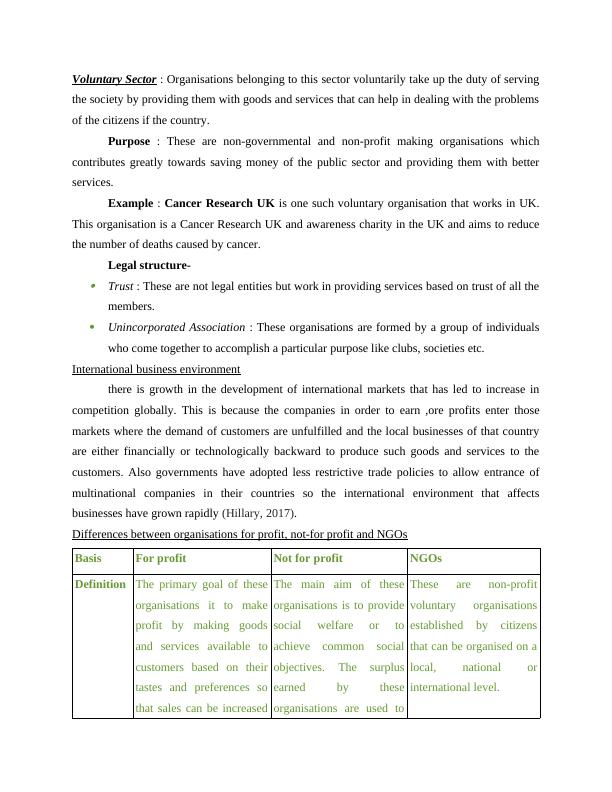Different Types and Purposes of Organisations with Their Legal Structures
Added on 2023-01-19
21 Pages6427 Words87 Views
Business and Business
Environment
Environment

Table of Contents
INTRODUCTION...........................................................................................................................3
TASK 1............................................................................................................................................3
P1 Different types and purposes of organisations with their legal structures.............................3
P2 Size and scope of different types of organisations.................................................................5
TASK 2............................................................................................................................................6
P3 Organisational functions and their interrelationships with each other...................................6
TASK 3............................................................................................................................................8
P4 Identify the positive and negative impacts of macro environment........................................8
TASK 4..........................................................................................................................................10
P5 Conduct internal and external analysis of organisation by analysing strength and
weaknesses................................................................................................................................10
P6 Explain how strength and weaknesses interrelated with external factors............................11
CONCLUSION..............................................................................................................................13
REFERENCES..............................................................................................................................14
INTRODUCTION...........................................................................................................................3
TASK 1............................................................................................................................................3
P1 Different types and purposes of organisations with their legal structures.............................3
P2 Size and scope of different types of organisations.................................................................5
TASK 2............................................................................................................................................6
P3 Organisational functions and their interrelationships with each other...................................6
TASK 3............................................................................................................................................8
P4 Identify the positive and negative impacts of macro environment........................................8
TASK 4..........................................................................................................................................10
P5 Conduct internal and external analysis of organisation by analysing strength and
weaknesses................................................................................................................................10
P6 Explain how strength and weaknesses interrelated with external factors............................11
CONCLUSION..............................................................................................................................13
REFERENCES..............................................................................................................................14

INTRODUCTION
The business environment consists of all the internal and external factors and forces that
influence the business efficiency and performance. They also affect the ability of business to
build string and long-term relations with their customers. These factors can be either internal i.e.
can be controlled and changed like employees, board of directors etc. while there are also
external factors which cannot be changed or controlled but can only be dealt with by changing
the strategies and policies of business by the management like political, economic factors etc.
This report explains about different types, purposes, size and scope of organisations which can
be private, public and voluntary (Al-Mutairi, Connerton and Dingwall, 2015). The organisations
taken for successfully completing the report are H &M which is a private organisation, Cancer
Research UK which is a voluntary organisation and Network Rail which is a public sector
organisation. All these organisations have their bases in UK and various factors of the country
affects these organisations which will be discussed in detail in this report.
TASK 1
P1 Different types and purposes of organisations with their legal structures
In an economy of the country different types of organisations work and function so as to
earn profits, contribute towards the GDP of the country, provide opportunities to general public
and provide customers with the goods and services they need and want which helps in growing
and developing the economy of the country. Following types of organisations that exist in UK
are given below :
Public sector : The organisations belonging this sector are generally owned and operated by the
government and work towards providing welfare services to the citizens.
Purpose : These organisations do not seek to earn profits but they charge reasonable fees
from the citizens for their successful functioning and maintenance.
Example :Network Rail is an example of public sector organisation in UK and is
responsible for maintaining the infrastructure of most of the railway network in Great Britain
(Calabrese and et. al., 2018).
Legal structure of Public sector - Central government : They collect funds from public through income tax. Local government : They collect funds from Community charges i.e. council tax.
The business environment consists of all the internal and external factors and forces that
influence the business efficiency and performance. They also affect the ability of business to
build string and long-term relations with their customers. These factors can be either internal i.e.
can be controlled and changed like employees, board of directors etc. while there are also
external factors which cannot be changed or controlled but can only be dealt with by changing
the strategies and policies of business by the management like political, economic factors etc.
This report explains about different types, purposes, size and scope of organisations which can
be private, public and voluntary (Al-Mutairi, Connerton and Dingwall, 2015). The organisations
taken for successfully completing the report are H &M which is a private organisation, Cancer
Research UK which is a voluntary organisation and Network Rail which is a public sector
organisation. All these organisations have their bases in UK and various factors of the country
affects these organisations which will be discussed in detail in this report.
TASK 1
P1 Different types and purposes of organisations with their legal structures
In an economy of the country different types of organisations work and function so as to
earn profits, contribute towards the GDP of the country, provide opportunities to general public
and provide customers with the goods and services they need and want which helps in growing
and developing the economy of the country. Following types of organisations that exist in UK
are given below :
Public sector : The organisations belonging this sector are generally owned and operated by the
government and work towards providing welfare services to the citizens.
Purpose : These organisations do not seek to earn profits but they charge reasonable fees
from the citizens for their successful functioning and maintenance.
Example :Network Rail is an example of public sector organisation in UK and is
responsible for maintaining the infrastructure of most of the railway network in Great Britain
(Calabrese and et. al., 2018).
Legal structure of Public sector - Central government : They collect funds from public through income tax. Local government : They collect funds from Community charges i.e. council tax.

State government : They own some of the organisations where central government cannot
interfere.
Private sector : These organisations are a part of economy and are sometimes also called citizen
sector as they are owned and operated by the individuals or groups.
Purpose : They operate in the economy for earning huge amount of profits by providing
customers with the goods and services in relation to their demands and play an important role in
bringing innovations in the market so that the unfulfilled demands of the customers can be met
and they can be provided with quality products (Gomes and Romão, 2015).
Example : Hennes and Mauritz (H&M) is one such private sector organisation that is
present in UK. It is a multinational clothing retail company and is well known for the fashionable
clothings it offers to its customers.
Legal structure - Sole proprietorship : This is owned and operated by a single person such as grocery shop,
taxi drivers. The sole traders are the people who open their business organisations
without facing government interventions and they do not have to be answerable to the
government about their working in the environment. Partnership : Formal agreement between parties which describes their ratio of sharing of
profits and losses. These organisations are established by forming a partnership deed
where the liabilities and the ratio in which the partners will share the profits and losses
associated with the company are determined so that conflicts do not occur in between all
the partners and the company can work within the rules of the deed. This deed helps the
firm in achieving its goals and objectives. Limited company : It is a legal structure that limits the liabilities of the company members
in relation to their contribution. These companies cannot offer their shares directly to the
public and are restricted by the government rules and regulations related to the limited
companies which helps the company in achieving its company goals. The stakeholders of
the company are limited to the value of shares they hold in the company or they can also
be limited to the amount they have guaranteed to pay in case the company face any
losses.
interfere.
Private sector : These organisations are a part of economy and are sometimes also called citizen
sector as they are owned and operated by the individuals or groups.
Purpose : They operate in the economy for earning huge amount of profits by providing
customers with the goods and services in relation to their demands and play an important role in
bringing innovations in the market so that the unfulfilled demands of the customers can be met
and they can be provided with quality products (Gomes and Romão, 2015).
Example : Hennes and Mauritz (H&M) is one such private sector organisation that is
present in UK. It is a multinational clothing retail company and is well known for the fashionable
clothings it offers to its customers.
Legal structure - Sole proprietorship : This is owned and operated by a single person such as grocery shop,
taxi drivers. The sole traders are the people who open their business organisations
without facing government interventions and they do not have to be answerable to the
government about their working in the environment. Partnership : Formal agreement between parties which describes their ratio of sharing of
profits and losses. These organisations are established by forming a partnership deed
where the liabilities and the ratio in which the partners will share the profits and losses
associated with the company are determined so that conflicts do not occur in between all
the partners and the company can work within the rules of the deed. This deed helps the
firm in achieving its goals and objectives. Limited company : It is a legal structure that limits the liabilities of the company members
in relation to their contribution. These companies cannot offer their shares directly to the
public and are restricted by the government rules and regulations related to the limited
companies which helps the company in achieving its company goals. The stakeholders of
the company are limited to the value of shares they hold in the company or they can also
be limited to the amount they have guaranteed to pay in case the company face any
losses.

Voluntary Sector : Organisations belonging to this sector voluntarily take up the duty of serving
the society by providing them with goods and services that can help in dealing with the problems
of the citizens if the country.
Purpose : These are non-governmental and non-profit making organisations which
contributes greatly towards saving money of the public sector and providing them with better
services.
Example : Cancer Research UK is one such voluntary organisation that works in UK.
This organisation is a Cancer Research UK and awareness charity in the UK and aims to reduce
the number of deaths caused by cancer.
Legal structure- Trust : These are not legal entities but work in providing services based on trust of all the
members.
Unincorporated Association : These organisations are formed by a group of individuals
who come together to accomplish a particular purpose like clubs, societies etc.
International business environment
there is growth in the development of international markets that has led to increase in
competition globally. This is because the companies in order to earn ,ore profits enter those
markets where the demand of customers are unfulfilled and the local businesses of that country
are either financially or technologically backward to produce such goods and services to the
customers. Also governments have adopted less restrictive trade policies to allow entrance of
multinational companies in their countries so the international environment that affects
businesses have grown rapidly (Hillary, 2017).
Differences between organisations for profit, not-for profit and NGOs
Basis For profit Not for profit NGOs
Definition The primary goal of these
organisations it to make
profit by making goods
and services available to
customers based on their
tastes and preferences so
that sales can be increased
The main aim of these
organisations is to provide
social welfare or to
achieve common social
objectives. The surplus
earned by these
organisations are used to
These are non-profit
voluntary organisations
established by citizens
that can be organised on a
local, national or
international level.
the society by providing them with goods and services that can help in dealing with the problems
of the citizens if the country.
Purpose : These are non-governmental and non-profit making organisations which
contributes greatly towards saving money of the public sector and providing them with better
services.
Example : Cancer Research UK is one such voluntary organisation that works in UK.
This organisation is a Cancer Research UK and awareness charity in the UK and aims to reduce
the number of deaths caused by cancer.
Legal structure- Trust : These are not legal entities but work in providing services based on trust of all the
members.
Unincorporated Association : These organisations are formed by a group of individuals
who come together to accomplish a particular purpose like clubs, societies etc.
International business environment
there is growth in the development of international markets that has led to increase in
competition globally. This is because the companies in order to earn ,ore profits enter those
markets where the demand of customers are unfulfilled and the local businesses of that country
are either financially or technologically backward to produce such goods and services to the
customers. Also governments have adopted less restrictive trade policies to allow entrance of
multinational companies in their countries so the international environment that affects
businesses have grown rapidly (Hillary, 2017).
Differences between organisations for profit, not-for profit and NGOs
Basis For profit Not for profit NGOs
Definition The primary goal of these
organisations it to make
profit by making goods
and services available to
customers based on their
tastes and preferences so
that sales can be increased
The main aim of these
organisations is to provide
social welfare or to
achieve common social
objectives. The surplus
earned by these
organisations are used to
These are non-profit
voluntary organisations
established by citizens
that can be organised on a
local, national or
international level.

and profits can be earned.
Their main focus is on
earning profits.
further achieve the
objectives.
Functions These organisations aim at
providing the customers
with goods and services
they need and want so that
profits can be earned by
selling the items to
customers. This will help
the organisations to
compete in the market
effectively and they can
also increase their market
share by reaching to large
number of customers.
These organisations
basically aim at providing
social care services so that
welfare and overall
upliftment of the societies
can be achieved. They do
not earn profits as this a
charitable work and the
persons involved form a
group by their own will to
bring social change with
no expectations of earning
profits.
These organisations are
not established by the
government of the
country but the people
involved in the
organisation aim at
providing welfare services
at a large scale so that
benefits can be given to
all the people of the
society.
Scope These organisations can
spread there businesses at
various locations as per the
assessment of the
profitability of their
expansion to different
places. Thes can be present
at the local, national and
international levels.
These organisations are
generally established to
bring welfare to a specific
community so that the
problems faced by that
community can be
eradicated. These
generally do not spread on
international levels.
These organisations aim
at bringing social welfare
at a large level and so
they can be established at
all the levels involving
local, national and
international so that
welfare at large scale can
be achieved.
Differences between micro, small and medium-sized enterprises
Basis Micro enterprises Small enterprise Medium enterprise
Meaning A micro-business has
less than ten
A small business has
less than 50 employees
A medium-sized
business has less than
Their main focus is on
earning profits.
further achieve the
objectives.
Functions These organisations aim at
providing the customers
with goods and services
they need and want so that
profits can be earned by
selling the items to
customers. This will help
the organisations to
compete in the market
effectively and they can
also increase their market
share by reaching to large
number of customers.
These organisations
basically aim at providing
social care services so that
welfare and overall
upliftment of the societies
can be achieved. They do
not earn profits as this a
charitable work and the
persons involved form a
group by their own will to
bring social change with
no expectations of earning
profits.
These organisations are
not established by the
government of the
country but the people
involved in the
organisation aim at
providing welfare services
at a large scale so that
benefits can be given to
all the people of the
society.
Scope These organisations can
spread there businesses at
various locations as per the
assessment of the
profitability of their
expansion to different
places. Thes can be present
at the local, national and
international levels.
These organisations are
generally established to
bring welfare to a specific
community so that the
problems faced by that
community can be
eradicated. These
generally do not spread on
international levels.
These organisations aim
at bringing social welfare
at a large level and so
they can be established at
all the levels involving
local, national and
international so that
welfare at large scale can
be achieved.
Differences between micro, small and medium-sized enterprises
Basis Micro enterprises Small enterprise Medium enterprise
Meaning A micro-business has
less than ten
A small business has
less than 50 employees
A medium-sized
business has less than

End of preview
Want to access all the pages? Upload your documents or become a member.
Related Documents
Business and Business Environmentlg...
|30
|1603
|84
Business and Business Environment Assignment - General Motorslg...
|14
|3795
|328
Relationship between Organisational Functions and their Interrelation with Objectives and Structurelg...
|13
|4514
|45
Business and the Business Environment: Types and Purposes of Organizations, Relationship between Organizational Functions, and PESTLE Analysis of Admiral Sportswearlg...
|14
|3579
|159
Types and Purposes of Organizations: A Study on Business and the Business Environmentlg...
|13
|3861
|76
Business Environment : KFClg...
|14
|4382
|153
